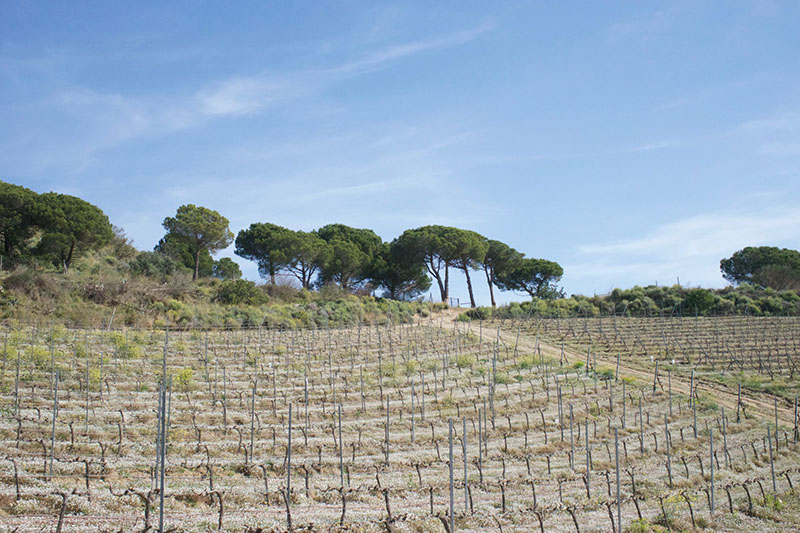From the top of the hill, you can see the Mediterranean sparkling on the horizon. Clusters of fat bees are bobbing and weaving, drunk on the nectar of the yellow wildflowers they’re inspecting. An incessant warble of bird call trills overhead carried by the constant breeze that blows up from the sea.
We are standing at the top of the amphitheater, as they call it here at Alta Alella, the u-shaped set of terraces which hold the majority of the vineyard’s experimental vines. My tour guide, Matilde, has brought me up here for a quick look at Alella’s operation, but we’re so entranced by the view that neither of us really wants to leave. We linger a little longer, me making up questions I didn’t have on my list, her telling me little stories about the work and her life before arriving at the vineyard. We wave to a neighbor on his morning walk along the public path that runs along the property’s back fence.
We observe the little white butterflies that flutter wildly around our legs, their petal-soft wings catching the bright sun. Don’t be fooled, Matilde tells me. They’re beautiful but destructive. Their tiny legs puncture the grapes’ delicate skin, she explains, ruining them for harvest. They are controlled through a method known as hormone therapy, which uses different hormones to divert their interest away from the grapes. It’s a crafty solution born out of necessity and one that organic winemakers know well: how to control the destructive work of nature without the use of pesticides.
Alta Alella’s location inside the Serralada Marina National Park is both a blessing and a curse. Because it’s located inside the park, everything is strictly controlled by the government. Most notably, the vineyard cannot use pesticides or any other destructive means to control the area’s abundant wildlife. Butterflies may be tricked with hormones, but birds are another matter, Matilde explains. The call of the birds across the vineyards is persistent and charming, but their indiscriminate feeding takes its toll on the harvest. She laughs. Well, the relationship is love/hate, she elaborates. Despite the problems they cause, their beloved presence has won them a place on the labels of a new series of natural wines. While they can create minor complications for farming the land, what they gives in return is priceless: an idyllic landscape in which to grow excellent grapes, from the purest soil and a profusion of wildlife, from carpets of wildflowers to a proliferation of songbirds, rabbits, and butterflies that dot the hillsides. Yet, with wine-making, as in nature itself, everything is about balance. It is not a question of destroying the natural threats, but about controlling them.
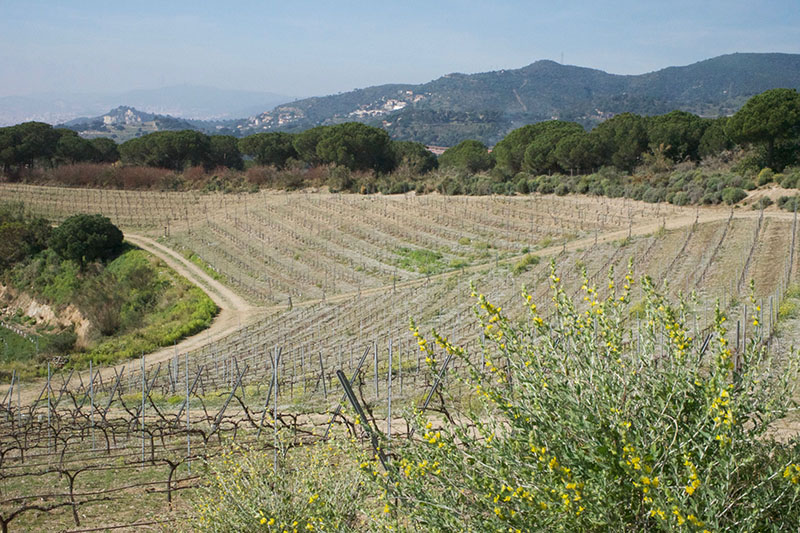
Alta Alella is an amazing place to work, she tells me. With a view like this, it’s not difficult to believe her. But it’s clear by the way she talks about it that it’s not only the environment that she loves. She has a lot of respect for the work they do and for her boss, owner Josep Maria Pujol-Busquets, who built this vineyard from the ground up.
Perched on the top of the hill that overlooks the town of Alella, Alta Alella takes its name from its prime location–alta means high in Catalan. It’s a 17-hectare pocket in what is essentially a mostly-developed suburban neighborhood. Today, there are only six vineyards in D.O. Alella, mostly making small production, boutique wines from old vines that have been carefully resuscitated after a phylloxera epidemic that destroyed almost all of them. With an impressive list of 25 wines and cavas, Alta Alella is the largest of the bunch. Yet, when Josep Maria bought the place back in 1991, the land had just a handful of withered vines and an abandoned house, Can Genís, which he set about renovating to become the family’s home. It took ten years to revitalize the land, and in 2001 he produced his first bottles of wine.
The move was a sort of homecoming for the Catalan, who had spent the previous decade abroad working as an enologist for some of the most illustrious winemakers in France and Italy, most notably at Martini-Rossi, where he became a bit of a maverick in the development of sparkling wines. Josep had grown up in nearby Badalona, a working-class town just a fifteen minutes’ drive north of Barcelona, but left to start his career, one which brought him a deeper understanding of wine and a fair reputation as an enologist. While he cultivated his knowledge at other vineyards, something deeper was taking root, a desire to cultivate his own land and to make his own wines, which eventually drove him back to familiar ground and to Alella, a few minutes’ drive from where he grew up and whose abandoned vineyards invited an experienced hand.
Located only 18 short kilometers outside of Barcelona, Alella is a quaint seaside enclave that was once the summer playground of Barcelona’s wealthy elites. They bought their summer homes in the hills above the sea, and enjoyed in equal parts the entrancing views and the fine wines that the region had been producing since the Romans had ruled the land in the 3rd century. Historically, Alella’s wines were controlled by the bourgeois families of Barcelona (then called Barcino) who supplied them to the King of Aragon and even exported them to America. At the end of the 19th century, the phylloxera epidemic hit, destroying the vines and sending Alella’s wine-making tradition into obscurity.
He wanted to put to use all he had learned while he was away, but he also wanted his project to be true to the land where he would put down new roots. He also wanted the wines he made to be a clear expression of their particular terroir. So, he began by planting local varietals like Pansa Blanca (Alella’s name for the Xarel·lo used in cava), including the forgotten Mataró grape, which has become a sort of rising star in Alta Alella’s history. Indeed the vineyard’s most renowned wine, Dolç Mataro, is made from it. The sweet dessert wine has been fondly deemed Alta Alella’s “spoiled child,” since it exploded onto the scene after being picked up by a sommelier from London’s The Fat Duck. It’s since graced the lists of some of the most iconic restaurants, from Daniel in New York to Catalunya’s own El Bulli.
It’s no surprise that Josep Maria, as an internationally recognized enologist, was able to produce an award-winning wine. In fact, he’s made several. But the quest to make excellent wines is not about having his wines on a Michelin-starred list. For him, it’s something much more personal. It’s about being able to pull forth the very best qualities of each grape and to produce wines that show the best possible expression of their particular terroir–the salty notes of the sea; the alkaline granite soil–and that is always a challenge to achieve. Matilde sums it up neatly: “He’s a bit of a perfectionist,” she says with a smile.
As the son of a sardanas musician, Josep Maria considers music is a familiar language. It’sno surprise, then, that he often explains his work through the metaphor of music. Together an orchestra can make magic, he says, but if one person plays a discordant note, everyone hears it. Hesays the vineyard is like an orchestra. It takes a lot of people to make good wine, but if one person does something wrong, everything suffers. As a winemaker, Josep Maria is a lot like a composer, creating a harmonic whole from a blend of different grape varietals, fine tuning each one until it’s perfect. He distills each of the varietals separately, experimenting with different fermentation tanks, in order to be produce a clean base with which to blend.
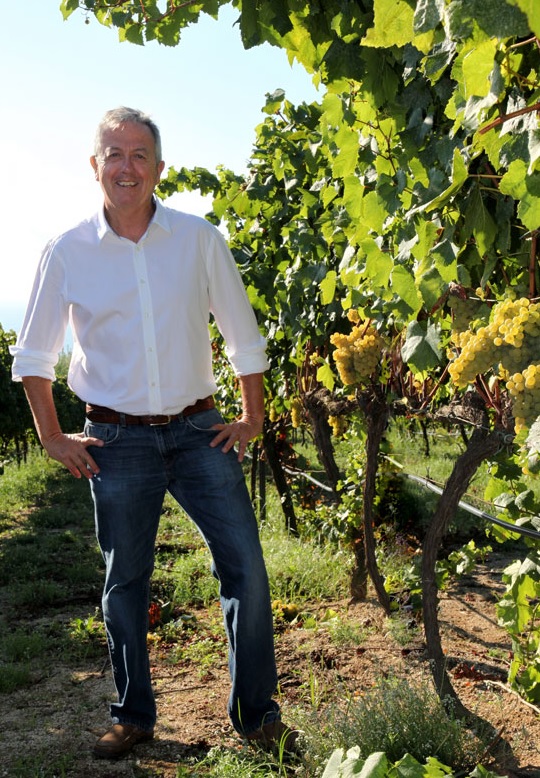
For the moment, Josep Maria seems to have the formula right. He’s producing excellent wines at the highest volume possible while remaining extremely mindful about the environment. Every building is conceived and developed to produce the least amount of stress on the environment. The main cellar has been built above ground and takes as its main wall, the side of the mountain it’s built against. The other buildings have green roofs. Large sheets of glass and carefully manicured plantings help the buildings blend into their natural surroundings. They’ve recently built a new cellar–the Celler de les Aus (Birds Cellar)– where they produce natural (read: sulfite-free) wines. Although, Josep Maria chafes against the inherent complications of the term “natural” by discarding it altogether, referring to them instead as simply “radical.” Built only out of the elements of the natural landscape and a single black sail, it is one of the least impactful structures of all.
The demand for his wines continues to grow, but Alta Alella has reached its growing capacity. In response, the team is seeking ways to expand without overburdening the land or growing against the limits mandated by the natural park. It’s further complicated by the fact that they run one of the most urban vineyards in Spain. The contours of the landscape help obscure the tennis courts and neighborhood homes just past its front gates. Josep Maria has sought a solution in which they will rent and harvest surrounding plots from local farmers, many of which are home to largely abandoned vines. They will teach the owners how to resuscitate and maintain the vines, offering vital skills and recuperating the land in the process.
In the meantime, Josep Maria continues to explore what he can do with the land and the grapes he already has. Many of the vines that are planted in the amphitheatre are not even approved for winemaking in D.O. Alella, but it doesn’t stop Josep Maria, just in case someday he’s approved to use them.
“He’s constantly experimenting. If it were up to him we’d have a new wine every year. Or maybe more than one,” says Matilde with a smile. “Someone has to say stop.”
WHAT TO TRY
Privat Opus Evolutium Cava
Pansa Blanca, Chardonnay, and Pinot Noir
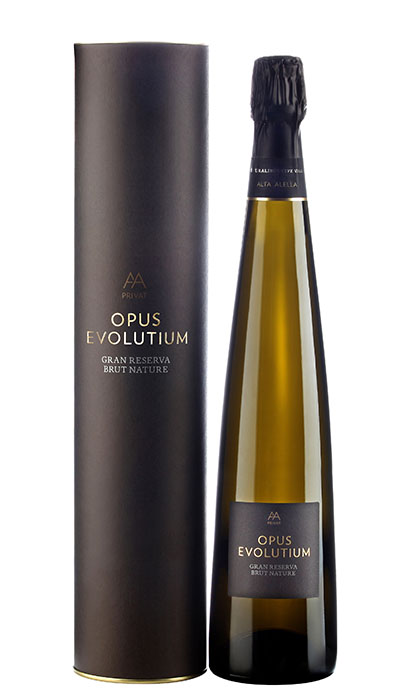
With 4 years aging (the minimum aging for cava is 30 months), this Gran Reserva cava is aromatic and persistent with creamy, gentle bubbles. It has notes of mature white fruits on the forefront and musky hints of orange blossom and acacia in the background. A brut nature (no sugar added), it’s dry and crisp, with additional spicy notes of citrus bark and ginger. It pairs well with fish and pasta dishes, as well as aperitivo foods like crisp croquettes and Spanish tortilla.
Don’t want to drink the whole bottle? No problem, keep it fresh here.
Parvus Chardonnay
100% Chadonnay
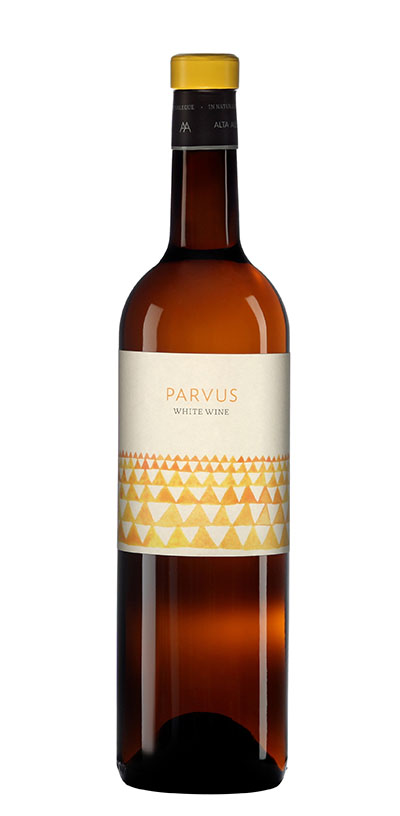
This unoaked white is perfect for the summer, offering a very fresh bouquet of tropical and mature fruits like mango, melon, and peach and an almost saline crispness that makes it a perfect pairing for fragrant dishes with lemongrass and mint, like Thai curries, salads, or roasted vegetables.
Dolc Mataró
100% Mataró

A medium-bodied dessert wine, Dolc Mataró is jammy on the nose with mature stone fruits like plum and cherry and hints of licorice, citrus peel, and floral notes, but its two months in French oak lend it an an earthy complexity (think: raisins, leather, cocoa, black tea) that makes it a true pleasure to drink. This show-stopper is an excellent pairing for dark chocolate and fruit-driven desserts, but it also works well with the savory set, like foie and rich cheeses like blue and goat.
Great wine deserves a great opener. Find one here
About the Author: Melissa Leighty is freelance writer and photographer based in Barcelona, Spain. When she’s not writing about wine, she covers travel and food for Metropolitan and Miniguide and is at work on her first cookbook about Catalan cuisine. Visit her at www.melissaleighty.com and follow her latest culinary adventures on her food blog, Ataula. She’s on Instagram as well @mpleighty and @ataula_co.

